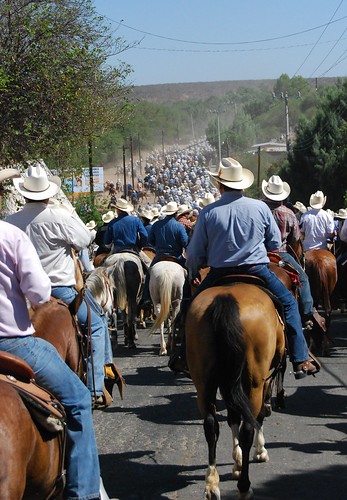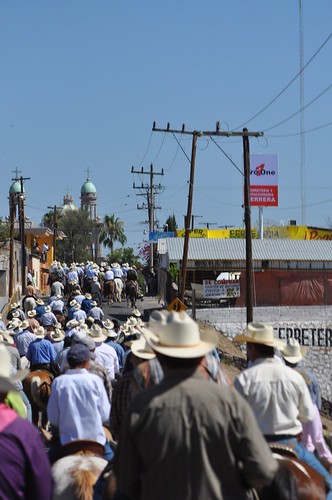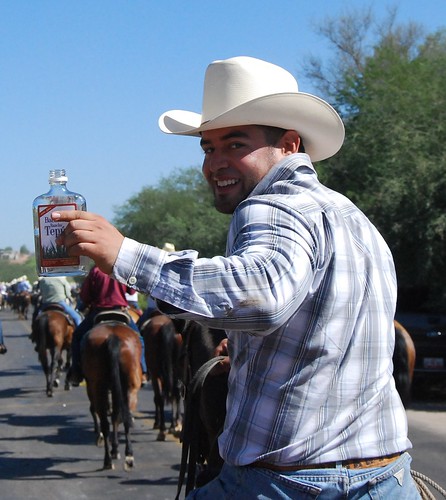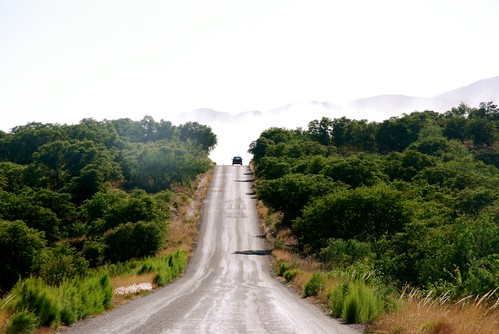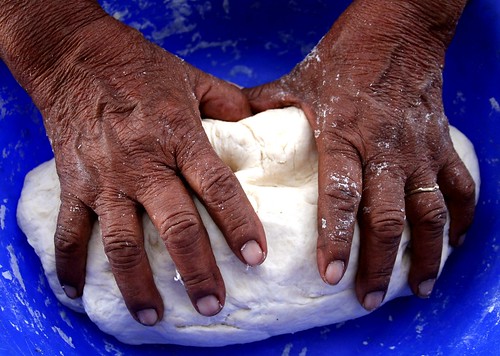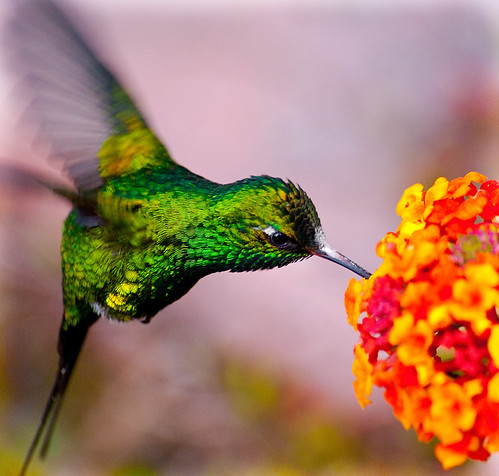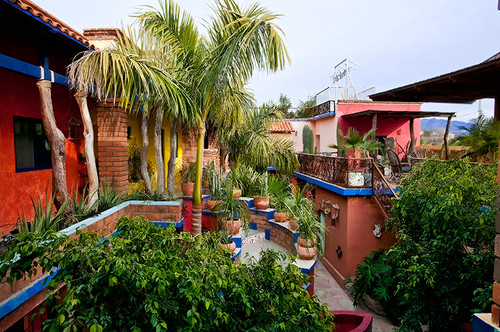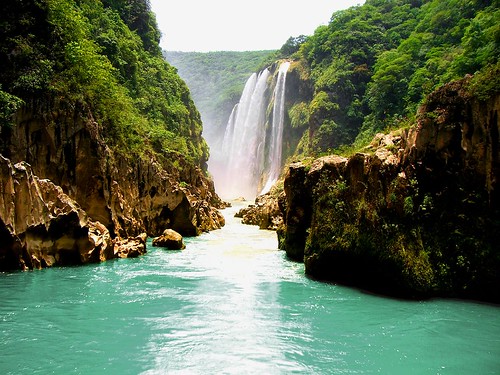To get a glimpse of the numbers...x 20, estimated at 2500 riders. I will be brief and say.....it was AWESOME!!!
Sometimes, you find your destiny and sometimes, it finds you. (Banamichi, Sonora River Valley by Bill Steen)
Thursday, June 24, 2010
As we enter Baviácora from the South
Our first and only Cabalgata so far was 24 kilometers long. We rode with approximately 2500 other riders (all of which wore white cowboy hats, while mine was dark brown). The Governor of Sonora Guillermo Padrés Elías (PAN), rode along with us. The entire ride lasted 3-1/2 hours and ended in La Estancia. We were hosted by the Contreras Family, they provided transportation, Great horses for Cheri and myself, sipping Tepúa Bacanora and cold beer. They watched over Cheri like she was a daughter or sister and this allowed me to mix with the crowd and sample other types of Bacanora, Tequila, Mescal and even some form of whiskey. It is amazing that I stayed on the horse, but had I fallen off or had any trouble, I am confident that there would have been plenty of friendly folks there ready to help. This event was absolutely AMAZING. I hope we can repay the kindness and generosity shown to us there. We made some "once-in-a-lifetime" memories that day.
DJ
The Tepúa Bacanora King Roberto
A new friend and a new family and a new home. Cheri and I are Blessed to have made so many great friends in such an amazingly short period of time. The genuine quality that I admire and respect so much in my new friends is their willingness to share and to help us forge into a new life. The Contreras Family of Hermosillo and the Rio Sonora area have been so kind to us. This photo is of Roberto Jr. and he is an incredible fellow, a bright young man that will help his Father achieve a family dream of making and marketing Bacanora (under the Tepúa label in Mexico and Cielo Rojo in the United States). We cannot wait to attempt to help them achieve their dreams as they have helped us with ours.
Finding Great people to have as friends is one of the greatest gifts we can have in our lives. I will always be Grateful!
Back on Pavement
Sometimes those rough patches in the road of life are there just to make you appreciate the smooth parts.
DJ
Wednesday, June 23, 2010
En la masa
Con las manos expertas Doña Lupe prepara tortillas de harina a la orilla de la playa de Bahía de Lobos, una pequeña población pesquera del Municipio de San Ignacio Río Muerto que, frente a lo ordinario de sus calles y casas, ofrece al visitante un escándalo de naturaleza sin par.
Uploaded by Fano_Quiriego on 13 Oct 09, 10.25PM MST.
With the expert hands Doña Lupe flour tortillas , prepared at the edge of the beach of Bahia de Lobos, a small fishing village of San Ignacio Rio Dead that, contrary to the ordinary streets and houses, offers visitors an unparalleled nature scandal .
This album had some of the best photos of children I have seen. Cheri nailed it when she said "If people (Gringos) could only see the happiness on the children's faces, then they wouldn't be trying so hard to change their culture..."
I really like the way Fano captured the hands.
Wonderful Water in Sonora
I have been asked by several friends and relatives about the water around the area. They all know me and Cheri and know how important water and natural beauty is in our day-to-day lives. My foto-search on Flickr with the query of "Sonora Beauty" brought me this striking image from Iván Fernández V. of a Dam and water reservoir. I wanted to share this via the easy (almost too easy) "Blog This" feature from Flickr. This Álvaro Obregón Dam has been captured so beautifully with the sky and earth and water.
A message manipulated by Hate, Fear & Ignorance
"Thank God for the border patrol that this did not come over the border. "
"Look what they found at the Arizona border!"
Sent to me in an attempt to warn me of the dangers of Mexico, by those whom have never been.
Taking images (from others) and trying to tell a story (lies and deception) of how the Mexican Drug Cartels are trying to smuggle guns and ammo North of the Border and that US Military captured them. Which was a series of lies that were 180 degrees from the Truth.... but via ignorance and the ease of forwarding to all your email buddies and they in turn to theirs and on and on. That is how Fear, Lies and Propaganda spreads like wildfire all across the good ole USA.
South of the Border, confiscated by Mexicans......
Exactly what do you think you are seeing here?
This is a Mexican Military Operation confiscating more than 300 long guns, 200 short guns, grenade launchers, RPG's , grenades, ammunition and vehicles all being smuggled from the United States to the Narco-Traffickers that in return try to keep Americans supplied with the Cocaine, Marijuana, Chrystal Meth, and now even Heroine that they can't ever seem to get enough of. I am glad to see that at least one side of the Border is being Pro-Active in this 185 Billion Dollar per year drug/arms trade. When was the last or even first time you can remember any of our more than 3500 ICE Agents along the Border stop the U.S. Gun Smugglers before they can make their way across the Border heading South? Why is Arizona the most concentrated area of weapons and ammunition sales in ratio to population in the Western Hemisphere? Where do you think all those "legally purchased" guns and ammunition is going? Go online and see where the "Big Gun Wholesalers" and "Bulk Ammunition" sales companies are located.
To the untrained eye, some folks might be easily mistaken in believing that these are American Armed Forces capturing weapons being smuggled North into our country. Anyone believing that may as well believe that the USA is the largest drug smugglers and providers of illegal drugs to Mexico and all of Latin America. With that logic, you would have to also believe that Mexico has a higher percentage of it's population addicted to drugs than anywhere else on the planet. Any and all of these assumptions would be 180 degrees wrong and would represent the height of ignorance and the ability of propaganda to lead uninformed people in any direction, even to believe in the opposite of Truth.
Uploaded by MexicoEcoResort on 23 Jun 10, 6.47AM MST.
Monday, June 21, 2010
The Colors of La Posada del Rio Sonora
This photo by my great friend Bill Steen is still my favorite image of the hotel. We finally did it! Now I am trying to handle getting both houses sold and do my Ultra Job while still planning ways to bring new customers to the hotel. www.MexicoEcoResort.com and www.LaPosadadelRioSonora.com are our two websites and I am trying to remake both of them. Each one will have a defined and separate focus and demographic target.
Please feel free to FB or Twit or share in any way possible. We need Your Help. Thanks for all the support so far. We couldn't have done it without it.
Ciao for now!
DJ
A Guest Survey - Please feel free to fill-out and submit if you have stayed there
If you have stayed there in the past, could you be sure to add approximate date in the last field before hitting submit? Also I would really like to have your email address...please, It is for hotel promotions only.
Sunday, June 20, 2010
Buchichiqui
There have been some awesome photos made of Hummingbirds/Collibri but this one is my new fav on Flickr. I have been exploring the images from Old Mexico from so many Great Mexican Photographers. In fact I have joined several of the photo groups focused on Old Mexico and specifically Sonora, and even more specific - La Ruta del Rio Sonora. It is a great way to share a common hobby and an enchantment with the landscape and the people of Mexico.
Viva Mexico!
Saturday, June 19, 2010
Upper Terrace View in the Morning
Upper Terrace View in the Morning, originally uploaded by MexicoEcoResort.
This is the first video post that I have tried from Flickr. It should give you a breif look around the upper terrace at La Posada. The back apartment is being rented by a Gold Miner's Daughter and the front apartment has just been occupied by our General Manager.
Please make plans to come and visit us after we make the Big Move. Now it is just a matter of time.
DJ
La Posada Patio & Courtyard
Mine at last...well ours actually. Although there have been no big "Press Release" regarding this transaction, it is official now. Cheri and I have purchased "La Posada del Rio Sonora" in Banámichi and will be moving there later this year. We are keeping on all the staff and even promoting Mauro Maldonado to General Manager. Over the next couple of weeks you will most likely notice a new look if you check in on our two websites: www.MexicoEcoResort.com and www.LaPosadadelRioSonora.com
Please share this on FB or any medium you can. We are counting on making this non-typical, non-touristy experience successful by generating as much good old fashioned fun and adventure as we can in this beautiful location. It is hard to describe, but impossible to forget. Just ask the folks that have been there.
This will be the beginning of an entirely new chapter in our lives.
Saturday, June 12, 2010
Cascada de Tamul @ Tanchachin, SLP, Mexico
Tomorrow is the "Cabogata" a horse festival with around 2,000 riders including the Governor of Sonora. Cheri and I will be riding thanks to the Contreras Family. Roberto Contreras Sr. and Jr. are the proprietors of "Cielo Rojo" (Red Sky) Bacanora (a type of tequila). We want to thank them in advance. They also sell it under the name "Tepua" in Mexico and we are more than proud to serve it in our signature drink at "La Posada del Rio Sonora" - Bacarita.
Find out more at www.MexicoEcoResort.com
Sunday, June 06, 2010
Choices (to wait or not to wait)
Dr. Seuss’ words about waitingClearly to Dr. Seuss, waiting is not a good thing. (& I agree)
The Waiting Place…
…for people just waiting.
Waiting for a train to go
or a bus to come, or a plane to go
or the mail to come, or the rain to go
or the phone to ring, or the snow to snow
or waiting around for a Yes or a No
or waiting for their hair to grow.
Everyone is just waiting.
Waiting for the fish to bite
or waiting for wind to fly a kite
or waiting around for Friday night
or waiting, perhaps, for their Uncle Jake
or a pot to boil, or a Better Break
or a sting of pearls, or a pair of pants
or a wig with curls, or Another Chance.
Everyone is just waiting.
I read it again recently and one part keeps popping in my head. The story warns the boy about getting lost in life’s “rat race.” Not taking action, but instead just …waiting.
Enter Franz Kafka. As a writer, he’s one of the all-time greats. As a boy born in Prague in a German Jewish family, Kafka struggled with identity. A minority of a minority. He didn’t accept it well. It was tough times for Franz and his writing shows it. His dark writing style was usually about “senseless, disorienting, often menacing complexity.” (sources)
What’s Kafka say about waiting?
Kafka’s words about WaitingIn a Nutshell…
You do not need to leave your room. Remain sitting at your table and listen. Do not even listen, simply wait, be quiet, still and solitary. The world will freely offer itself to you to be unmasked, it has no choice, it will roll in ecstasy at your feet.
There you have it.
Seuss says: waiting = bad
Kafka says: waiting = good
What are your thoughts?
Anyway, this is what’s weighing heavily on my mind,
.......today and the past few weeks.
Thanks for reading,
-DJ
Mexico-our New Winner
Moving up four places to take our top spot as the world’s top retirement haven this year is Mexico. Mexico offers the perfect mix of centuries-old traditions and contemporary lifestyles. Moving to Mexico means you can still have all of the amenities you grew accustomed to north of the border: cable TV, high-speed Internet, and modern home appliances. And if you prefer, when you move to Mexico you can even bring all of your favorite things with you without paying import taxes.
Goods and services cost less, so you can afford the kinds of luxuries only the very wealthy enjoy up north: a maid, a cook, and a gardener for example. In your retirement here, you’ll have time to volunteer at the local school, time to golf in the mornings, time to relax on the beach…time to savor life.
Whether your vision of the ideal retirement involves shopping, fishing, sunbathing, diving, biking, mountain climbing, parasailing, collecting crafts, visiting archeological sites, partying, going to concerts, attending the theater, or fine dining, in Mexico you can engage in all of these activities, and many more.
How our Global Retirement Index is scored
* Real estate. Countries where real estate prices are low and the purchase of real estate is relatively easy receive the highest scores. We use our own experiences plus reports from our contributing editors and real estate contacts around the world to rate each country. Weight: 15%
* Entertainment, Recreation, and Culture. This category considers the number of newspapers per 1,000 citizens, the number of museums and cinemas per capita, the number of university students, the literacy rate, and the variety of cultural and recreational offerings. Weight: 10%
* Cost of living. This score is based on statistics from the Indexes of Living Costs Abroad, Quarter Allowances, and Hardship Differentials, published by the United States Department of State, and on data published by Business International. We also use our firsthand experiences living and traveling in these countries. The lower the score, the higher the cost of living. Weight: 20%
* Safety and stability. This measure of unrest in each country is based primarily on Interpol data and State Department statistics. It also takes into account the civil liberties and political rights granted by each government. Our own experiences and reports from expatriates living in these countries also influence the safety scores. Weight: 5%
* Health care. Considered in this category are the cost of a typical visit to a general practitioner and the cost and coverage particulars of health insurance. Weight: 20%
* Climate. Countries with temperate weather throughout the year, moderate rain fall, and little risk of natural disaster come out on top in this category. We use data representing each country as a whole instead of favoring one region over another. Weight: 5%
* Special benefits. This category considers government provisions that make moving to and living in each country easier and more affordable for foreigners. Taken into account are property rights for foreign residents, property tax rates, duty-free imports on personal belongings, currency controls, employment restrictions, voting rights, and transportation discounts for seniors. Weight: 20%
* Infrastructure. This section considers the number of cars and telephones per 1,000 residents, the length of railroad track in usable condition, the number of airports, the quality of the country’s road and highway network, and the availability of telecommunications. Weight: 5%
If health care is a concern, you should know that in much of Mexico the health care is first rate. Private clinics and hospitals are staffed by expert physicians (many of whom trained in the U.S., Europe, or in Mexico’s own world-renowned teaching hospitals), and medical care and prescription drugs will cost you only a fraction of what you would pay in the States. In our Index, Mexico scores 79 out of a possible 100 points in this category.
Mexico is such a diverse nation that everybody can find exactly what they want. You don’t have to choose between water or mountains; here you can have both. And because of geographic diversity, you can also choose the climate to enjoy during your Mexican retirement: from hot and dry in the north, to hot and humid in the south, to spring-like temperatures all year round in the Colonial Highlands.
You can also own the home of your dreams in Mexico-for much less than it would cost you most anywhere in the U.S. or Canada. The real estate market offers endless possibilities for your retirement. Mexico receives a high score of 84 in our Real Estate category. Despite what you may have heard, it’s not too late to buy real estate here.
You can own beachfront-not just ocean view property-in Mexico for less than $100,000.
Once you decide to move to Mexico, it’s difficult to know where to go-it’s a big country. Below are the 10 places we think make the most sense for expatriate living in this country, based on criteria such as health care, climate, infrastructure, and housing costs. These are places our husband-and-wife team in Mexico, Dan Prescher and Suzan Haskins, have personally scouted and personally recommend above other options in this great big country. They are: Rosarito Beach, Puerto Vallarta, Quer?ro, Mazatlan, M?da, La Paz, Campeche, Playa del Carmen/Riviera Maya, Ajijic/Chapala, and Sayulita/San Pancho (San Francisco). Of course, we’re not forgetting San Miguel de Allende, one of Dan and Suzan’s favorite places in Mexico. Suzan recently reported of this town: “San Miguel is one of the prettiest towns in all of Mexico. Stepping into San Miguel’s Centro is like stepping back in time…but with all of today’s modern conveniences.”
In second place…
Ecuador
Ecuador always does well in our Retirement Index,.....
Top for Europe
Italy comes third in our Index this year with high scores across the board. It’s difficult to......
Why Panama fell from glory?
Panama won our Retirement Index for six years in a row. But, it’s fallen from the top spot....
Mexico drug war doesn’t stop Americans from moving south of the border

By Sara Miller Llana
Mérida, Mexico
Bill Engle is outside, sweating in work clothes while he oversees renovations to his colonial house in Mérida, Mexico. It sits on a street dubbed “Gringo Gulch,” a pretty row of baby blue, violet, and mustard facades where expatriates outnumber Mexicans.
“It is not the climate,” says Mr. Engle, explaining why he moved to the Yucatán Peninsula. “It is the people. It is the most welcoming place.”
Americans scared off by violence in Mexico? Not here.
In towns far from the US border such as Mérida, Mexico’s drug wars seem like another world. In fact, according to a recent survey by the International Community Foundation, violence reduced the frequency or duration of trips to Mexico for only 7 percent of American retirees who live or travel frequently to Mexico.
No one knows how many foreign retirees, entrepreneurs, and families relocated to Mérida in recent years, but judging from real estate deals, new members to the English-language library, and observations by locals, it is not a few – nor is it ebbing.
'As safe as Seattle'"I feel more part of a community here and safer or as safe here as I did in Seattle," says Martha Lindley, a retired chaplain and lawyer who moved here three years ago.
Of 5.25 million Americans living abroad, 1 million are estimated to live south of the border. Some communities, such as San Miguel de Allende (a Heritage Site in central Mexico), seem virtual US suburbs. Mérida is becoming a magnet as transplants rush to buy old mansions and haciendas from the 19th century boom in henequen (a fiber used to make rope).
"I do not feel any violence here," says Dan Karnes, a retired lawyer from New Orleans who moved here last year. He purchased an 18th-century colonial mansion, last used as a warehouse, and on a recent day was overseeing workers digging a pool foundation and laying an oval courtyard. When done, Mr. Karnes will boast an 18,300-square-foot home.
Mérida housing market rebounds with retirees Mérida became a hot destination five years ago, says Mitch Keenan of Mexico International Real Estate. He's sold homes here for 15 years. While the global recession hurt sales, he says the market is rebounding and sending in more well-heeled retirees.
With America's baby boomers retiring, potential for further growth is huge. The International Community Foundation found that Mexico remains their retirees' No. 1 travel destination. The possible extension of Medicare benefits to Americans who retire abroad could further fuel that.
Ellen Fields and her husband, Jim, run the site Yucatanliving.com and help expatriates settle here with the company Yucatan Expatriate Services. "It is so neighborly," she says. She once left her keys in her door; instead of getting robbed, the keys got returned.
Locals say foreigners blend easily with the city's 1 million residents.
Alvaro Martinez and Sara Lopez, who moved to "Gringo Gulch" 70 years ago, long before it earned its nickname, are one of two Mexican families on the street. "They are good neighbors, there are never any problems," says Mr. Lopez, his arm draped around his wife. "They are moving in all around us."
csmonitor.com
Mexico's health care lures Americans
Saturday, June 05, 2010
Does driving a 4x4 through the canyons and in the river sound FUN?
Courtesy TerritorioScuola
This eight minute video done by Robert from New Years shows the hotel really well. It also shows how fun driving the "Old River Route" can be. Don't get me wrong the scenic 98 is incredible and probably one of the least used and most scenic drives in the Southwest, but for a real adventure I prefer the more watery route. We have done this a couple of times and each time it still thrills me.
The greenish-yellowish highlighted route from Nogales to Magdelena to Cocurpe to Banámichi is absolutely the fastest way from Tucson. We usually go through Bisbee and Naco toward Canennea and turn South on 98 (which is marked 118 and my Garmin shows as Hwy 17) just before entering Canennea. This is what most would consider the scenic route. Probably takes 30-45 more minutes than Nogales going down, (depending on city traffic), but the return portion is so much easier for me at Naco that I choose this route going North. If I am in no big hurry I turn off toward Bamori at this sign-
about 15-20 miles North of Banámichi there is a dirt road to the right. If you look back 20 yards/meters after turning on this road and see the sign above, you are on the right road. (I will try to include lat lon soon) but you get the idea. Then just follow the road through a little village and make your first river crossing and bear left where the most defined marks are, in a worse case scenario wait until you see a cowboy on a horse and see which way they are heading or ask "Arizpe" and point, they will laugh and point you in the right direction. After all getting a little lost on a wagon trail that criss-crosses the river about a dozen times is part of the adventure, right? We never needed 4x4, but may need it during monsoon season when I expect much higher water levels and rougher road conditions.
Then if you are lucky, you will roll into the Southside of Arizpe on a shady tree-lined smoothe dirt road that is where the teenagers and young folk hang out after church on Sunday afternoons. We even saw several of those gorgeous Sonoran girls riding bareback. A couple of them sharing a horse almost ran into a tree while flirting with this old gringo in the old 4x4 Montero. Cheri was telling me to keep my eyes on the road....and believe me I was, but I was driving sllooooww to take in all the sights and sounds and finally the smooth feel of pavement. Then we backtracked a bit on the main road and had a Great Lunch at the Pemex on the Southside of Arizpe. Leave a note on a napkin under the clear plastic table-clothe if you do make it there, and tell 'em DJ and Cheri sent ya (they won't understand a word of it, but they will smile and feed you some really great food at a very decent price anyway).
Tinamastes Banámichi
Activities:
*Outdoor Training
*Excursiones/ Excursions
*Rappel/ Rappel Training
*Cañonismo / Rock Climbing
*Puentismo (Rappel in Real World)
*Senderismo / Hiking
*Bici de Montaña / Mountain Biking
*Paintball
*Tours Off Road
A.P. Impact: US-Mexico border isn't so dangerous
It's the U.S.-Mexico border, and even as politicians say more federal troops are needed to fight rising violence, government data obtained by The Associated Press show it actually isn't so dangerous after all.
The top four big cities in America with the lowest rates of violent crime are all in border states: San Diego, Phoenix, El Paso and Austin, according to a new FBI report. And an in-house Customs and Border Protection report shows that Border Patrol agents face far less danger than street cops in most U.S. cities.
The Customs and Border Protection study, obtained with a Freedom of Information Act request, shows 3 percent of Border Patrol agents and officers were assaulted last year, mostly when assailants threw rocks at them. That compares with 11 percent of police officers and sheriff's deputies assaulted during the same period, usually with guns or knives.
In addition, violent attacks against agents declined in 2009 along most of the border for the first time in seven years. So far this year assaults are slightly up, but data is incomplete.
"The border is safer now than it's ever been," said U.S. Customs and Border Protection spokesman Lloyd Easterling.
Can you domesticate a wild Javelina? ....only in Banámichi
I found this short video of a local Banámichi Hombre that has done just that,
made a pet out of a wild pig. Only in a place as tranquil as Banámichi.....
Thursday, June 03, 2010
"Where the River Turns"
Blog Archive
-
▼
2010
(83)
-
▼
June
(24)
- Cabalgata 2010 Rio Sonora
- As we enter Baviácora from the South
- The Tepúa Bacanora King Roberto
- Back on Pavement
- En la masa
- Wonderful Water in Sonora
- Opata Words Defined
- A message manipulated by Hate, Fear & Ignorance
- The Colors of La Posada del Rio Sonora
- A Guest Survey - Please feel free to fill-out and ...
- Buchichiqui
- Upper Terrace View in the Morning
- La Posada Patio & Courtyard
- Cascada de Tamul @ Tanchachin, SLP, Mexico
- Choices (to wait or not to wait)
- Google Search to a New Life
- Mexico-our New Winner
- Mexico drug war doesn’t stop Americans from moving...
- Mexico's health care lures Americans
- Does driving a 4x4 through the canyons and in the ...
- Tinamastes Banámichi
- A.P. Impact: US-Mexico border isn't so dangerous
- Can you domesticate a wild Javelina? ....only in B...
- "Where the River Turns"
-
▼
June
(24)
Working Towards Paradise
About Us

- Darrin Jones aka DJ ( and Cheri...)
- "Attitude is Everything" "God let me WANT what I already HAVE.." "Always look for the miracles in life that surround us"
